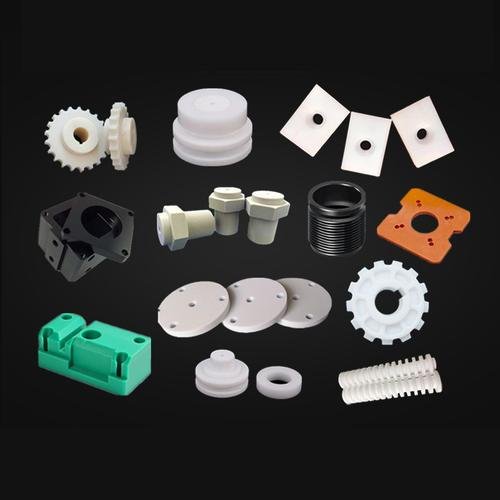
CNC Plastic Parts:
CNC (Computer Numerical Control) machining technology, renowned for its high precision and efficiency, is widely adopted in plastic component manufacturing. Different plastic materials, each possessing unique physical and chemical properties, are suited for distinct application domains. The following provides a systematic overview of commonly used plastic materials in CNC machining and their core application areas, aiming to assist your product design and material selection.
I. Classification and Properties of CNC Plastic Materials
1. Engineering Plastics (High-Performance Type)
Engineering plastics offer superior mechanical strength, heat resistance, and chemical stability, making them suitable for functional components in demanding environments.
ABS (Acrylonitrile Butadiene Styrene)
Characteristics: High toughness, impact resistance, easy machinability, and good surface gloss.
CNC Machinability: Stable cutting performance, suitable for complex structural parts.
Applications: Electronic device housings (e.g., routers, remote controls), automotive interior components, toy prototypes.
PC (Polycarbonate)
Characteristics: High transparency (light transmittance ≥90%), impact resistance, high-temperature resistance (-40°C to 130°C).
CNC Machinability: Requires controlled cutting temperatures to prevent stress cracking.
Applications: Optical lenses, medical device housings, protective visors, LED lamp covers.
PA (Nylon, Polyamide)
Characteristics: High strength, wear resistance, self-lubricating, relatively high moisture absorption.
CNC Machinability: Use carbide tools to minimize burrs.
Applications: Gears, bearings, pulleys, automotive engine compartment components.
POM (Polyoxymethylene)
Properties: Low friction coefficient, high rigidity, fatigue resistance.
CNC Machinability: Low cutting forces, suitable for precision micro-part machining.
Applications: Precision gears, transmission components, electronic connectors.
2. High-Performance Plastics (Extreme Environment Applications)
Suitable for high-temperature, highly corrosive, or high-load scenarios. Higher cost but exceptional performance.
PEEK (Polyetheretherketone)
Properties: High-temperature resistance (continuous use up to 260°C), chemical corrosion resistance, biocompatibility.
CNC Machinability: Requires diamond tools to prevent high-temperature deformation.
Applications: Aerospace structural components, medical devices (e.g., surgical instruments), semiconductor equipment parts.
PI (Polyimide)
Properties: High-temperature resistance (above 300°C), strong insulation, radiation resistance.
CNC Machinability: Highly brittle material; requires optimized cutting parameters.
Applications: Flexible circuit board substrates, spacecraft thermal insulation layers, nuclear industry components.
PPS (Polyphenylene Sulfide)
Properties: High-temperature resistance, solvent resistance, excellent dimensional stability.
CNC Machinability: Prone to static electricity during cutting; dust control required.
Applications: Automotive sensors, electronic component encapsulation, chemical pump bodies.
3. General-Purpose Plastics (Low-Cost Type)
Low cost, easy to process; suitable for non-critical structures or disposable items.
PMMA (Acrylic, Polymethyl Methacrylate)
Properties: High transparency (92% light transmittance), high surface hardness, prone to brittle fracture.
CNC Machinability: Feed rate must be controlled to prevent chipping.
Applications: Display stands, lampshades, optical instrument light guides.
PP (Polypropylene)
Properties: Chemical resistance, good toughness, low density (0.9 g/cm³).
CNC Machinability: Prone to burrs, requires secondary grinding.
Applications: Chemical containers, daily goods (e.g., water cups), automotive bumpers.
PE (Polyethylene)
Properties: Low-temperature resistance, excellent flexibility, good electrical insulation.
CNC Machinability: Soft material, requires sharp cutting tools.
Applications: Pipe fittings, seals, packaging materials.
4. Specialty Plastics (Function-Oriented)
Materials engineered for specific requirements, such as conductivity, thermal conductivity, or flame retardancy.
Conductive Plastics (e.g., PC/ABS + Carbon Fiber)
Properties: Surface resistivity 10³~10⁶Ω, antistatic.
Applications: Electronic device housings (EMC shielding), mining equipment components.
Thermal Conductive Plastics (e.g., PA + graphene)
Properties: Thermal conductivity 5–20 W/(m·K), replaces metal for heat dissipation.
Applications: LED heat sinks, power module housings.
Flame-Retardant Plastics (e.g., PC + flame retardants)
Properties: UL94 V-0 certified, self-extinguishing upon flame removal.
Applications: Appliance housings, charging station structural components.
